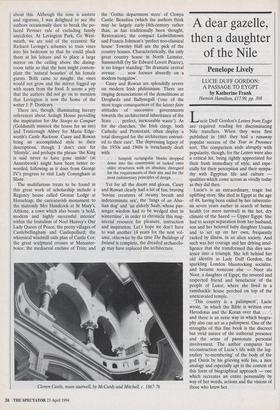Build, unbuild, contrive to save appearances
Hugh Massingberd
THE BUILDINGS OF IRELAND: NORTH LEINSTER by Christine Casey and Alistair Rowan Penguin, 130, pp. 576 It has been a long wait for the second volume in the 'Irish Pevsner'; Alistair Rowan's admirably astringent first effort, covering North West Ulster (the counties of Londonderry, Donegal, Fermanagh and Tyrone), appeared back in 1979. This time the Belfast boy, now Principal of his alma mater the Edinburgh College of Art, has joined forces with Christine Casey from Co Louth, the bright young (b. 1960) curator of Newman House, Dublin's first Georgian museum, to tackle an area that includes her own native county, as well as Longford, Meath and Westmeath.
The new book sticks to the familiar Pevsner pattern ea Prussian corset', as it has been called by one of the late Sir Nikolaus's less ardent admirers) of intro- ductory overview and rigorously architec- tural gazetteer. One cannot help wishing for more photographs. When the original Buildings of England series (from which this is a spin-oft) was devised in the 1940s, the reproduction and printing of photographs presented practical difficulties, but these have long since been overcome and I can see no reason why the new, taller format could not accommodate a much larger number of 'integrated' illustrations. As Pevsner's old sparring partner Sir John Betjeman used to say, 'one good illustra- tion is worth 20 pages of text'.
Casey and Rowan's text is impeccably judicious and crisp, though occasionally a little wobbly on genealogy and heraldry. In the entry for Bracklyn House, for instance, the authors score a left and a right by not- ing that it was 'acquired from the Packen- hams [sic] by the Fetherston Haugh [sic] family'. The Fetherstonhaughs are one family, not two. And at Stackallen (or Steckallan, as it is more usually known) Gustavus Hamilton's coat of arms is not `hand [sic] with that of his wife, Elizabeth Brooke of Brookeborough'; the correct word is 'impaled'.
There is also rather too much archaeolo- gy for my taste, but as the northern bank of the Boyne boasts the three great burial mounds of Dowth, Knowth and New- grange, it may be churlish to complain about this. Although the tone is austere and rigorous, I was delighted to see the authors occasionally dare to break the po- faced Pevsner rule of excluding family anecdotes. At Levington Park, Co West- meath, we are told of the eccentric Sir Richard Levinge's schemes to train vines into his bedroom so that he could pluck them at his leisure and to place a large mirror on the ceiling above the dining- room table so that the host might contem- plate the 'natural beauties' of his female guests. Both came to naught: the vines would not grow and the mirror fogged up with steam from the food. It seems a pity that the authors did not go on to mention that Levington is now the home of the writer J. P. Donleavy.
There are, though, illuminating literary references about Ardagh House providing the inspiration for She Stoops to Conquer (Goldsmith mistook the house for an inn) and Tristernagh Abbey for Maria Edge- worth's Castle Rackrent. Casey and Rowan bring an accomplished style to their descriptions, though I don't care for `lifestyle', and perhaps the phrase 'the King is said never to have gone inside' (at Annesbrook) might have been better re- worded, following as it does from George IV's progress to visit Lady Conyngham at Slane.
The multifarious treats to be found in this great work of scholarship include a Regency house called Grouse Lodge at Horseleap; the caricaturish monument to the matronly Mrs Handcock at St Mary's, Athlone, a town which also boasts 'a bold, modern and highly successful interior' within the brutalism of Noel Heavey's Our Lady Queen of Peace; the pretty villages of Castlebellingham and Castlepollard; the whimsical windmill sails plan of Castle Cor; the great sculptural crosses at Monaster- boice; the mediaeval enclave of Trim; and the 'Gothic department store' of Clonyn Castle. Beaulieu (which the authors think may be largely early-18th-century rather than, as has traditionally been thought, Restoration), the compact Ledwithstown and Francis Johnson's 'perfect neo-classical house' Townley Hall are the pick of the country houses. Characteristically, the only great country house in North Leinster, Summerhill (by Sir Edward Lovett Pearce), is no longer standing: 'Its dramatic central avenue . . . now focuses absurdly on a modern bungalow'.
Casey and Rowan are splendidly severe on modern Irish philistinism. There are ringing denunciations of the demolitions at Drogheda and Ballynegall Cone of the most tragic consequences of the laissez-faire attitudes of successive governments towards the architectural inheritance of the State . . . perfect, inexcusable waste'). As for the churches, 'the Irish clergy, both Catholic and Protestant, often display a total disregard for the architecture entrust- ed to their care'. The depressing legacy of the 1950s and 1960s is trenchantly dealt with: . . . lumpish rectangular blocks dropped down into the countryside or tacked onto older structures with an absolute disregard for the requirements of their site and for the most rudimentary principles of design.
Yet for all the doom and gloom, Casey and Rowan clearly had a lot of fun, braving `bovine creatures of steamy breath and indeterminate sex', the 'fangs of an Alsa- tian dog' and 'an elderly Saab, whose pas- senger window had to be wedged shut in wintertime', in order to chronicle this mag- isterial resource for pleasure, instruction and inspiration. Let's hope we don't have to wait another 14 years for the next vol- ume, otherwise by the time The Buildings of Ireland is complete, the dreaded archaeolo- gy may have replaced the architecture.
Clonyn Castle, main stairwell, by McCurdy and Mitchell, c. 1867-76



























































 Previous page
Previous page